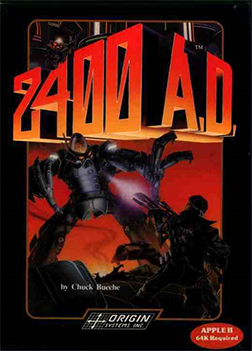2400 A.D.
| 2400 A.D. | |
|---|---|

Cover art
|
|
| Developer(s) | Origin Systems |
| Publisher(s) | Origin Systems |
| Designer(s) | Chuck Bueche |
| Platform(s) | Apple II, DOS |
| Release date(s) | 1987 (Apple II) 1988 (DOS) |
| Genre(s) | Adventure |
| Mode(s) | Single-player |
2400 A.D. is a 1987 role-playing video game designed by Chuck Bueche and published by Origin Systems. It was developed for the DOS and Apple II platforms; a version for the Commodore 64 was planned, but never completed.
This post-apocalyptic RPG casts the player as a member of an underground resistance organization trying to free the human inhabitants of planet XK-120 from the clutches of a tyrannical race of robotic oppressors known as the Tzorgs. The ultimate aim is to destroy the robots' central control.
In this RPG by Chuck Bueche, the player plays the role of an ordinary citizen who lives in the futuristic city Metropolis. The city has been conquered, and its population enslaved by an alien race known as Tzorgs. They have sent robots to maintain order in Metropolis, turning it into a police state. There are rumors of an underground resistance movement, but finding the resistance is dangerous, and being caught by the robots will lead to being thrown in prison...
The gameplay style is very similar to the Ultima series, also from Origin Systems. The entire game is viewed from top-down perspective. The various commands (search, open, talk, etc.) are executed by pressing a correspondent key on the keyboard. Battles take place on the same screen as exploration, and require the player to press A (for "attack") and a directional key to aim at the enemy. The game is set entirely in the big city, with streets and buildings to explore, items and weapons to buy, and people to talk to.
In addition to a large fold out city map, 2400 AD was packaged with a set of three lead figures. All three depict heavily armed robot soldiers and were cast by Grenadier Miniatures (two in 1984 and one in 1987).
Computer Gaming World in 1988 criticized 2400 A.D.'s graphics and several other flaws with the game's structure and plot. It concluded "the game lacks intensity and is a disappointment. There are practically no puzzles, and hardly any challenge". In 1993 the magazine called 2400 A.D. "a science fiction cartoon pretending to be a real game" that "may be good for a summer afternoon or rainy day when you want something that isn't mentally taxing or especially involving".
...
Wikipedia
